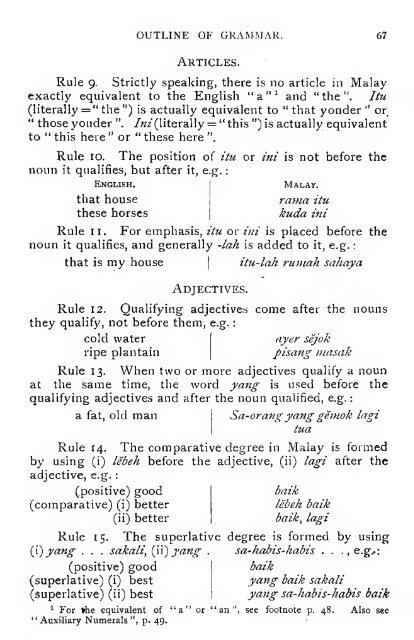Malay self-taught by the natural method : with ... - Sabrizain.org
Malay self-taught by the natural method : with ... - Sabrizain.org
Malay self-taught by the natural method : with ... - Sabrizain.org
You also want an ePaper? Increase the reach of your titles
YUMPU automatically turns print PDFs into web optimized ePapers that Google loves.
OUTLINE OF GRAMMAR. 67<br />
Articles.<br />
Rule 9. Strictly speaking, <strong>the</strong>re is no article in <strong>Malay</strong><br />
exactly equivalent to <strong>the</strong> English "a"' and "<strong>the</strong>". Itu<br />
(literally = " <strong>the</strong>") is actually equivalent to "that yonder" or<br />
" those yonder ". /^/(literally = "this ")is actually equivalent<br />
to " this here " or " <strong>the</strong>se here ".<br />
Rule 10. The position of itu or ini is not before <strong>the</strong><br />
noun it qualifies, but after it, e.g.<br />
English.<br />
<strong>Malay</strong>.<br />
that house<br />
rania itu<br />
<strong>the</strong>se horses<br />
kudo, ini<br />
Rule II. For emphasis, itu or ini is placed before <strong>the</strong><br />
noun it qualifies, and generally -lah is added to it, e.g<br />
that is my house |<br />
itu-lah<br />
: :<br />
Adjectives.<br />
riimah sahaya<br />
Rule 12. Qualifying adjectives come after <strong>the</strong> nouns<br />
<strong>the</strong>y qualify, not before <strong>the</strong>m, e.g.<br />
cold water ayer sejok<br />
ripe plantain pisang uiasak<br />
Rule 13. When two or more adjectives qualify a noun<br />
at <strong>the</strong> same time, <strong>the</strong> word yang is used before <strong>the</strong><br />
qualifying adjectives and after <strong>the</strong> noun qualified, e.g.<br />
a fat, old man Sa-orang yang gemok lagi<br />
tua<br />
Rule 14. The comparative degree in <strong>Malay</strong> is formed<br />
<strong>by</strong> using (i) ISbeh before <strong>the</strong> adjective, (ii) lagi after <strong>the</strong><br />
adjective, e.g. :<br />
(positive) good<br />
(comparative) (i) better<br />
(ii) better<br />
(}) yang .<br />
baik<br />
lebeh baik<br />
baik, lagi<br />
Rule 15. The superlative degree is formed <strong>by</strong> using<br />
. . sakali, (U) yang .<br />
(positive) good<br />
(superlative) (i) best<br />
(superlative) (ii) best<br />
^ For <strong>the</strong> equivalent of<br />
"Auxiliary Numerals", p. 49.<br />
sa-hahis-habis . . ., e.g..:<br />
baik<br />
yang baik sakali<br />
yang sa-habis-habis baik<br />
see footnote p. 48. Also see<br />
:

















